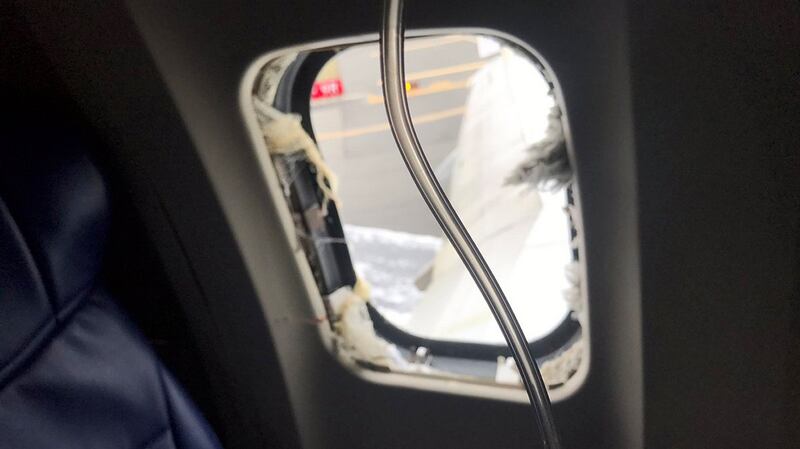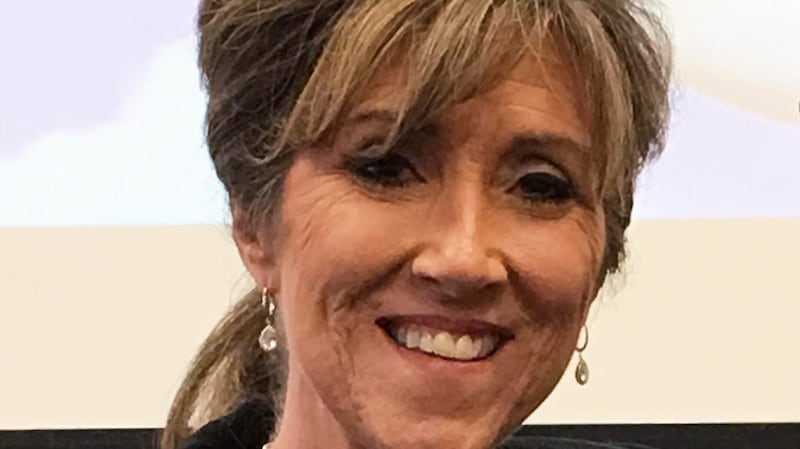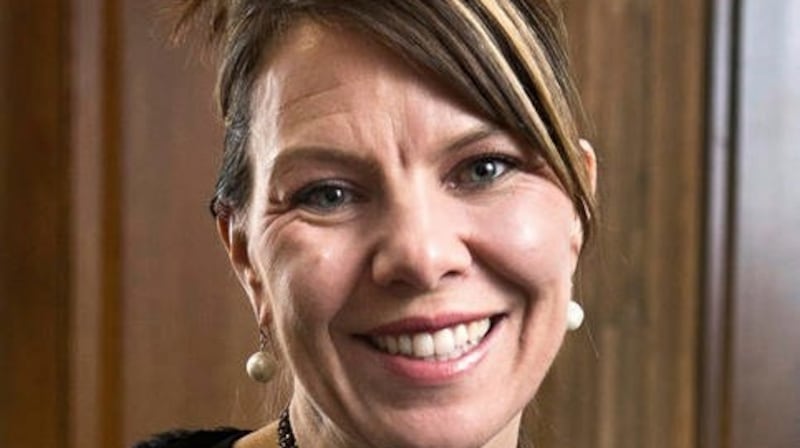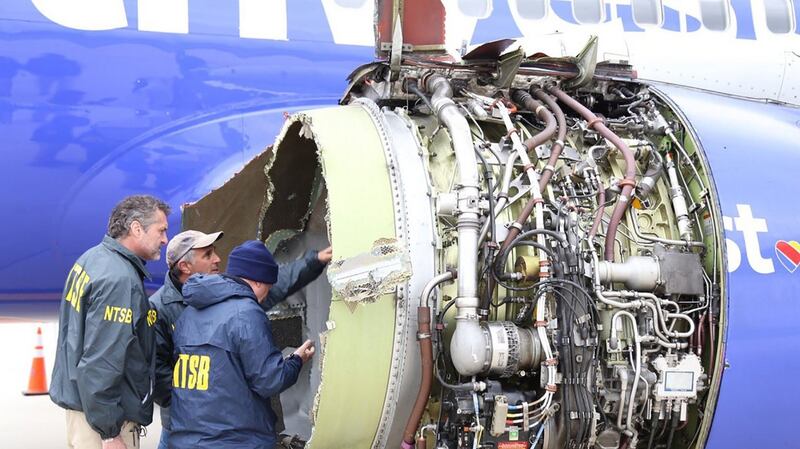Tens of thousands of feet above the Earth, the passengers clasped hands with strangers, prayed together and got ready to die.
Moments earlier on Tuesday morning, they had been playing Sudoku, catching up on their reading for church and curling up together to watch funny movies as their Southwest Airlines flight climbed above 9,000 metres on its way from New York to Dallas.
It was about 11am Eastern time (4pm Irish time), 20 minutes into a four-hour flight, as they skimmed above the clouds and waited for flight attendants to hand out drinks.
Then, with a deafening roar, Flight 1380 became a midair scene of chaos and terror for the 144 passengers and five crew members on board. With no apparent warning, the plane’s left engine exploded after one of its fan blades broke off. A gust of shrapnel blew out a window, partly sucking one passenger in Row 14 headfirst into the sky. Oxygen masks dropped down, and the plane plunged thousands of metres in a minute.

Over the next 20 minutes, the depressurised cabin air swirled with wind and debris, panic and prayers as the pilot rerouted the plane to Philadelphia for an emergency landing.
“I grabbed my wife’s hand and I started praying: ‘Dear Jesus, send some angels. Just save us from this,’” said Timothy Bourman (36) a pastor from Queens who was on his way to a church retreat in San Antonio. “I thought we were goners.”
In the cockpit, Tammie Jo Shults, a veteran navy pilot, flew with one engine, displaying what one passenger would later call “nerves of steel”. Shults was well trained to handle stress in the cockpit. She had flown supersonic F/A-18 Hornets as one of the US navy’s first female pilots at a time when women were still barred from combat duty, before leaving active service in 1993.

Shults calmly radioed air traffic controllers in Philadelphia to discuss her approach. She told them the flight was carrying injured passengers and needed emergency medics on the ground.
“Is your airplane physically on fire?” an air traffic controller asked Shults, according to audio captured by LiveATC. “No it’s not on fire, but part of it is missing,” she responded. “They said there’s a hole and, uh, someone went out.”
Metal fatigue
It had all started so normally on Tuesday morning. When the Boeing 737 took off from La Guardia Airport, it was fresh off an inspection on Sunday night, although investigators on Wednesday said the likely cause of the explosion was metal fatigue in an engine blade.
Its passengers were New Yorkers heading to San Antonio or Dallas for a meeting or a technology conference. They were Texans and New Mexicans heading home after a magical first visit to New York City, an education conference in midtown Manhattan or a trip to see family.
They spent the morning at the airport making jokes about bag-check fees, snapping selfies on the plane, even getting into a tiff with another passenger about who got to board first. Just another day of air travel in America.
But by 11.10am, as the flight descended toward Philadelphia, those same passengers were scrambling to put on oxygen masks and buy internet access so they could send a last message to their children and families. Marty Martinez (29), of Dallas, held a yellow oxygen mask to his face as he live-streamed the descent on Facebook. “It appears we are going down!” he wrote.
Bourman said he could not figure out how to use his mask and decided it would not save him if the plane crashed. Instead, he sat and prayed as his wife, Amanda, managed to connect her phone to the plane’s Wi-Fi. They began texting Bourman’s father to tell him what had happened and to convey a message to the couple’s three daughters, 6, 4 and 2 years old:
Pray. Plane blew an engine. We are going to try to land. Tell the girls we love them and that Jesus is with them always.
Across from the blown-out window, Sheri Sears (43) thought about her 11-year-old daughter, Tyley. Sears’s own father had died when she was 7, and she kept thinking to herself: I’m not going to be there for her. Sears said she offered a thin prayer for mercy: “If this is your will, God, please let me go quickly. Don’t let me suffer.”
Tightened belts
Her friend and travel companion, Tim McGinty, reassured his wife and Sears that they would be fine and tightened their seat belts. Then he sprang up to help drag the injured passenger, Jennifer Riordan, back into the plane.
Riordan was unconscious and bleeding as McGinty and another passenger, a firefighter from north of Dallas, laid her across a row of seats. A retired nurse and flight attendants rushed up and helped McGinty perform CPR all the way to Philadelphia, but it was no use.
Riordan (43), a Wells Fargo executive and mother of two from Albuquerque, New Mexico, was pronounced dead at a hospital of what medical examiners later called blunt trauma to her head, neck and torso.

News of her death rippled through Albuquerque, where the chamber of commerce held a moment of silence and ranks of nonprofit leaders, arts advocates and others across the city mourned.
Courtney Padilla (34), a passenger from Albuquerque who was travelling home with her wife, mother, grandmother and aunt, said she had not met Riordan personally but knew her by name and her reputation as a community supporter.
Padilla and her family were sitting at the front of the plane when the engine exploded and, like other passengers, they stayed in their seats and held on to each other as the desperate attempt to save Riordan’s life played out just rows behind them.
A stranger beside Padilla assured her that she had just celebrated her 76th birthday and that they would not be dying that day. Padilla, in turn, made eye contact to support a younger girl sitting diagonally in front of her. “You were holding on to whoever was next to you,” Padilla said.
On the right side of the plane, over the wing, Jim Demetros (55) watched flight attendants carrying portable oxygen bottles thread along the aisle to make sure the passengers – who included a number of children – were secured.
Landing
As they approached Philadelphia International Airport, Demetros said, the plane vibrated as it made a slow turn. About two minutes before they landed, Matt Tranchin’s phone got reception, so he called his wife and told her they were about to hit the ground. He figured they had a 50-50 chance of surviving.

Over the intercom, the crew sternly told passengers to put their heads down and brace themselves. Sears held on to her friend in the seat next to her and wondered, “Will it stop? Will it crash? Will it explode?” It landed. It landed gently at around 11.20, and with whoops and applause, the passengers pulled out their mobile phones to text and call their families to report that they were all right.
The cabin went quiet as medics climbed on board and carried Riordan out on a stretcher, and flight attendants checked on seven other passengers who suffered minor injuries. They talked with the captain and crew and walked off the plane to talk to investigators, watching the story of Flight 1380 saturate the television screens around the airport as they waited for their new flights home. It was hard to grasp.
“We were really on that plane,” Sears said. “It’s unbelievable we made it through that.” – New York Times











